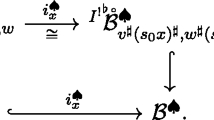Abstract
We analyze the criterion of the multiplicity-free theorem of representations [5, 6] and explain its generalization. The criterion is given by means of geometric conditions on an equivariant holomorphic vector bundle, namely, the ‘visibility’ of the action on a base space and the multiplicity-free property on a fiber.
Then, several finite-dimensional examples are presented to illustrate the general multiplicity-free theorem, in particular, explaining that three multiplicity-free results stem readily from a single geometry in our framework. Furthermore, we prove that an elementary geometric result on Grassmann varieties and a small number of multiplicity-free results give rise to all the cases of multiplicity-free tensor product representations of GL(n,C), for which Stembridge [12] has recently classified by completely different and combinatorial methods.
Similar content being viewed by others
References
Faraut, J. and Thomas, E. G. F.: Invariant Hilbert spaces of holomorphic functions, J. Lie Theory 9 (1999), 383–402.
Hoogenboom, B.: Intertwining Functions on Compact Lie Groups, CWI Tract 5, Stichting Mathematisch Centrum, Centrum voor Wiskunde en Informatica, Amsterdam, 1984.
Howe, R.: Perspectives on invariant theory: Schur duality, multiplicity-free actions and beyond, In: The Schur Lectures 1992, Israel Math. Conf. Proc. 8 (1995), pp. 1–182.
Kac, V.: Some remarks on nilpotent orbits, J. Algebra 64 (1980), 190–213.
Kobayashi, T.: Multiplicity-free theorem in branching problems of unitary highest weight modules, In: K. Mimachi (ed.), Proceedings of the Symposium on Representation Theory held at Saga, Kyushu 1997 (1997), pp. 9–17.
Kobayashi, T.: Multiplicity-free restrictions of unitary highest weight modules for reductive symmetric pairs, Preprint, UTMS 2000–1.
Kobayashi, T.: A generalized Cartan decomposition for the double coset space (U(p) × U(q)) \ U(n) / U(n1) x U(n2) x U(n3)), Preprint.
Kobayashi, T. and Nasrin, S.: Multiplicity one theorem in the orbit method, In: S. Gindikin (ed.), Lie Groups and Symmetric Spaces, In memory of F. I. Karpelevich, Translation Series 2, Amer. Math. Soc. 210 (2003), 161–169.
Krattenthaler, C.: Identities for classical group characters of nearly rectangular shape, J. Algebra 209 (1998), 1–64.
Littelmann, P.: On spherical double cones, J. Algebra 166 (1994), 142–157.
Okada, S.: Applications of minor summation formulas to rectangular-shaped representations of classical groups, J. Algebra 205 (1998), 337–367.
Stembridge, J. R.: Multiplicity-free products of Schur functions, Ann. Combin. 5 (2001), 113–121.
Author information
Authors and Affiliations
Rights and permissions
About this article
Cite this article
Kobayashi, T. Geometry of Multiplicity-Free Representations of GL(n), Visible Actions on Flag Varieties, and Triunity. Acta Applicandae Mathematicae 81, 129–146 (2004). https://doi.org/10.1023/B:ACAP.0000024198.46928.0c
Issue Date:
DOI: https://doi.org/10.1023/B:ACAP.0000024198.46928.0c




